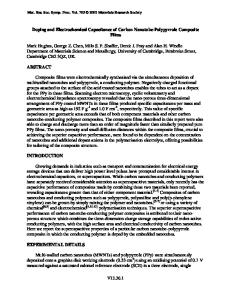Fiber organic electrochemical transistors based on multi-walled carbon nanotube and polypyrrole composites for noninvasi
- PDF / 5,315,696 Bytes
- 10 Pages / 595.276 x 790.866 pts Page_size
- 7 Downloads / 396 Views
RESEARCH PAPER
Fiber organic electrochemical transistors based on multi-walled carbon nanotube and polypyrrole composites for noninvasive lactate sensing Yang Zhang 1 & Yuedan Wang 1 & Xing Qing 1 & Yao Wang 1 & Weibing Zhong 1 & Wenwen Wang 1 & Yuanli Chen 1 & Qiongzhen Liu 1 & Mufang Li 1 & Dong Wang 1 Received: 11 May 2020 / Revised: 3 August 2020 / Accepted: 14 August 2020 # Springer-Verlag GmbH Germany, part of Springer Nature 2020
Abstract Multi-walled carbon nanotubes (MWCNT) play a synergistic role with conducting polymer in practical applications such as biological sensing. In this paper, multi-walled carbon nanotube and polypyrrole (PPy) composites were prepared on a fiber surface for the first time, and their morphology and electrical properties were characterized. Compared with PPy-coated fiber, the presence of carbon nanotubes induced the growth of large areas of PPy nanowires. In addition, fiber organic electrochemical transistors (FECTs) based on PPy and MWCNT were assembled, showing a higher on/off ratio, better stability, and greater flexibility. The lactate biosensor based on FECTs exhibits high sensitivity, with a correlation coefficient of R = 0.9889, quick response time of 0.6–0.8 s, a wide linear response range of 1 nM–1 mM, and excellent selectivity for lactate. Furthermore, the lactate concentration in human sweat was successfully detected by a FECT-based sensor. The hybrid fibers can be easily woven and placed on fabric simply by stitching. This favorable performance of the FECT-based sensor makes it suitable for noninvasive sensing of lactate. Therefore, it provides a promising platform for future use in healthcare and detection applications. Keywords Multi-walled carbon nanotube . Electrochemical transistor . Flexibility . Lactate sensor . Fiber
Introduction The determination of lactate is of great significance for clinical diagnostics, fermentation, and food analysis [1, 2]. In particular, lactate concentration is a key parameter in clinical diagnostics for predicting multiple organ failure and evaluating the health status of patients, such as monitoring respiratory insufficiency, metabolic disturbance, and psychological disorders [3–5]. Traditionally, chromatography and spectrophotometry have been used to analyze lactate concentrations [6–10]. However, these Electronic supplementary material The online version of this article (https://doi.org/10.1007/s00216-020-02886-0) contains supplementary material, which is available to authorized users. * Yuedan Wang [email protected] * Dong Wang [email protected] 1
Hubei Key Laboratory of Advanced Textile Materials & Application, Wuhan Textile University, Wuhan 430200, Hubei, China
methods are time-consuming, expensive, and complicated. Therefore, the development of methods for the rapid, efficient, and real-time monitoring of lactate concentration is critical. Electrochemical biosensors can provide quantitative information. Specifically, organic electrochemical transistors (OECTs) show great potential in biomolecule detection due to their un
Data Loading...











